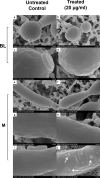Anti-Candida Antibodies of Patients with Invasive Candidiasis Inhibit Growth, Alter Cell Wall Structure, and Kill Candida albicans In Vitro
- PMID: 38324097
- PMCID: PMC10850236
- DOI: 10.1007/s11046-023-00819-w
Anti-Candida Antibodies of Patients with Invasive Candidiasis Inhibit Growth, Alter Cell Wall Structure, and Kill Candida albicans In Vitro
Abstract
Invasive candidiasis (IC), caused by Candida yeasts, particularly Candida albicans, poses a significant threat with high mortality rates. Diagnosis is challenging due to Candida's common presence in human microbiota. To address this, our research group developed an immunofluorescence assay detecting Candida albicans Germ Tube Antibodies (CAGTA) in IC patients. CAGTA, indicative of invasive processes, is associated with a lower mortality rate in ICU patients. Based on this premise, this study aims to provide results regarding the lack of knowledge about the potential activity of CAGTA against invasive infections in humans caused by the fungus Candida albicans. Therefore, in order to characterize the activity of CAGTA produced by patients with IC, we used sera from 29 patients with IC caused by either C. albicans or non-albicans Candida species. Whole serum IgG antibodies were fractionated into anti-blastospores, CAGTA-enriched, and purified CAGTA and the assessments included XTT colorimetric assays for metabolic activity, CFU counts for viability, and microscopy for growth, viability, and morphological analysis. The CAGTA-enriched IgG fraction significantly reduced the metabolic activity and viability of C. albicans compared to anti-blastospores. Purified CAGTA altered germ tube cell wall surfaces, as revealed by electron microscopy, and exhibited fungicidal properties by DiBAC fluorescent staining. In conclusion, antibodies in response to invasive candidiasis have antifungal activity against Candida albicans, influencing metabolic activity, viability, and cell wall structure, leading to cell death. These findings suggest the potential utility of CAGTA as diagnostic markers and support the possibility of developing immunization protocols against Candida infections.
Keywords: Antibodies; Candida albicans; Fungicides; Growth inhibitor; Invasive candidiasis.
© 2024. The Author(s).
Conflict of interest statement
We declare that we have no competing interests.
Figures





Similar articles
-
Anti-Candidaalbicans germ tube antibodies reduce in vitro growth and biofilm formation of C. albicans.Rev Iberoam Micol. 2019 Jan-Mar;36(1):9-16. doi: 10.1016/j.riam.2018.07.005. Epub 2019 Jan 24. Rev Iberoam Micol. 2019. PMID: 30686747
-
Candida albicans Germ-Tube Antibody: Evaluation of a New Automatic Assay for Diagnosing Invasive Candidiasis in ICU Patients.Mycopathologia. 2017 Aug;182(7-8):645-652. doi: 10.1007/s11046-017-0125-9. Epub 2017 Apr 4. Mycopathologia. 2017. PMID: 28378240
-
Clinical factors associated with a Candida albicans Germ Tube Antibody positive test in Intensive Care Unit patients.BMC Infect Dis. 2011 Mar 9;11:60. doi: 10.1186/1471-2334-11-60. BMC Infect Dis. 2011. PMID: 21388550 Free PMC article.
-
Diagnostic accuracy of Candida albicans germ tube antibody for invasive candidiasis: systematic review and meta-analysis.Diagn Microbiol Infect Dis. 2019 Apr;93(4):339-345. doi: 10.1016/j.diagmicrobio.2018.10.017. Epub 2018 Nov 6. Diagn Microbiol Infect Dis. 2019. PMID: 30552034
-
Diagnosis of Invasive Candidiasis: From Gold Standard Methods to Promising Leading-edge Technologies.Curr Top Med Chem. 2018;18(16):1375-1392. doi: 10.2174/1568026618666181025093146. Curr Top Med Chem. 2018. PMID: 30360714 Review.
Cited by
-
Diagnostic and Therapeutic Challenge Caused by Candida albicans and Aspergillus spp. Infections in a Pediatric Patient as a Complication of Acute Lymphoblastic Leukemia Treatment: A Case Report and Literature Review.Pathogens. 2024 Sep 7;13(9):772. doi: 10.3390/pathogens13090772. Pathogens. 2024. PMID: 39338963 Free PMC article. Review.
-
Preparation and analysis of quinoa active protein (QAP) and its mechanism of inhibiting Candida albicans from a transcriptome perspective.PeerJ. 2025 Feb 14;13:e18961. doi: 10.7717/peerj.18961. eCollection 2025. PeerJ. 2025. PMID: 39963196 Free PMC article.
References
MeSH terms
Substances
Supplementary concepts
Grants and funding
LinkOut - more resources
Full Text Sources
Medical

